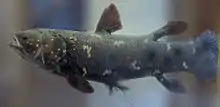coelacanth
See also: cœlacanth
English
Alternative forms
- cœlacanth (obsolete)
Etymology
From the New Latin genus name Coelacanthus, from Ancient Greek κοῖλος (koîlos, “hollow”) + ἄκανθα (ákantha, “spine”), referring to the hollow caudal fin rays of the first fossil specimen described and named by Louis Agassiz in 1839.[1]
Pronunciation
- IPA(key): /ˈsiː.lə.kænθ/
Audio (US) (file)
Noun
coelacanth (plural coelacanths)
- Either of two species of deep-water fish, Latimeria chalumnae of the Indian Ocean and Latimeria menadoensis of Indonesia.
- Any lobe-finned fish in the order Coelacanthiformes, thought until 1938 to have been extinct for 70 million years.
- 2018, Tim Flannery, Europe: A Natural History, page 32:
- Among them were ancient relatives of the piranhas and those popular aquarium fish the tetras, along with garfish and freshwater coelacanths, known as mawsonids.
Translations
either of two species of deep-water fish
|
any lobe-finned fish in the order Coelacanthiformes
|
References
- Douglas Harper (2001–2024) “coelacanth”, in Online Etymology Dictionary.
Further reading
 coelacanth on Wikipedia.Wikipedia
coelacanth on Wikipedia.Wikipedia  Latimeria chalumnae on Wikispecies.Wikispecies
Latimeria chalumnae on Wikispecies.Wikispecies  Latimeria on Wikispecies.Wikispecies
Latimeria on Wikispecies.Wikispecies  Latimeria chalumnae on Wikimedia Commons.Wikimedia Commons
Latimeria chalumnae on Wikimedia Commons.Wikimedia Commons
This article is issued from Wiktionary. The text is licensed under Creative Commons - Attribution - Sharealike. Additional terms may apply for the media files.
